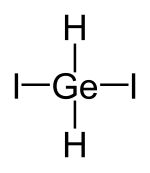Diiodgerman
| Structural formula | ||||||||||
|---|---|---|---|---|---|---|---|---|---|---|

|
||||||||||
| General | ||||||||||
| Surname | Diiodgerman | |||||||||
| Molecular formula | GeH 2 I 2 | |||||||||
| Brief description |
colorless solid |
|||||||||
| External identifiers / databases | ||||||||||
|
||||||||||
| properties | ||||||||||
| Molar mass | 328.43 g mol −1 | |||||||||
| Physical state |
firmly |
|||||||||
| Melting point |
45–47 ° C (decomposition) |
|||||||||
| safety instructions | ||||||||||
|
||||||||||
| As far as possible and customary, SI units are used. Unless otherwise noted, the data given apply to standard conditions . | ||||||||||
Diiodgerman is a chemical compound from the group of germane .
Extraction and presentation
Diiodgerman can be obtained by reacting dichlorogerman with hydrogen iodide , whereby the monochlorogerman , which is usually produced together with the dichlorogerman, serves as a solvent .
properties
Diiodgerman is a colorless crystalline solid that slowly turns yellow at room temperature, even under dry nitrogen . It is soluble in cyclohexane .
Individual evidence
- ↑ a b c d e Georg Brauer (Ed.), With the collaboration of Marianne Baudler u. a .: Handbook of Preparative Inorganic Chemistry. 3rd, revised edition. Volume I, Ferdinand Enke, Stuttgart 1975, ISBN 3-432-02328-6 , p. 731.
- ↑ This substance has either not yet been classified with regard to its hazardousness or a reliable and citable source has not yet been found.
